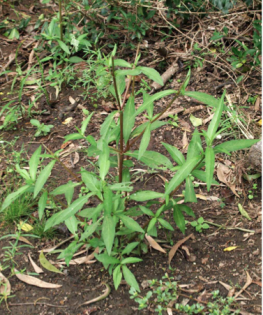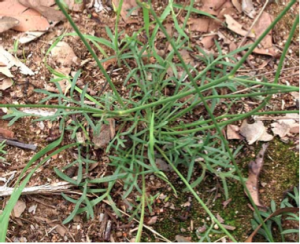Asteraceae
Chrysocephalum apiculatum
 Family: Asteraceae
Family: Asteraceae
Genus: Chrysocephalum
Common names: Yellow buttons
ALA reference
This hardy perennial loves open well-drained soil and a clump can be found in the grassy area beside Fort Road. It has soft grey-green foliage. This is a widespread species and can be found growing naturally in all States of Australia. (December 2007)
Cotula australis
 Family: Asteraceae
Family: Asteraceae
Genus: Cotula
Common names: Common Cotula, Carrot Weed
ALA reference
This little annual or occasionally perennial herb is appearing in considerable numbers in the areas that have been cleared. The leaves are superficially similar to the introduced plant Soliva sessilis (Bindii or Jo-jo weed) that is the scourge of many lawns. However it is easy to distinguish the native Cotula by the long flower spikes. (September 2008)
Cyanthillium cinereum
 Family: Asteraceae
Family: Asteraceae
Genus: Cyanthillium
Synonym: Vernonia cinerea
Common names: Little ironweed, Purple fleabane
ALA reference
This little annual or short-lived perennial was previously classified as Vernonia cinerea. Two quite distinct forms of this species can be found growing in the Reserve. However the two forms are not recognised by botanists as being botanically significant.
The first form, which I call Cyanthillium cinereum “Dr. Jekyll”, appears to me to be a sweet and lovely little native herb. It only grows to about 30 cm and has long rather narrow glabrous leaves. The mauve flowers are followed by heads of windborne seeds (achenes). This form can be found mainly in the eastern half of the Reserve with an obvious clump in a cleared area about halfway down the northern firetrail.
I call the second form Cyanthillium cinereum “Mr. Hyde”. This form appears to me be a rather gross and somewhat ugly ‘weed’. It grows to about a metre in height with rather broad and often hairy leaves. The leaves are always a paler green than the above form. It has masses of pale mauve to almost white flowers followed by heads of windborne seeds. This form is mostly found on the western edge of the Reserve, just below the picnic ground. However it too is a native plant and should be treated as such. (November 2010)
 This little annual or short-lived perennial was previously classified as Vernonia cinerea. It can be found growing along the cleared area which is the extension of Eddystone Road. The seed heads are about 10 mm in diameter and almost spherical. The individual seeds are about 2 mm long, surmounted by a small fluffy head. Like many plants with wind borne seeds it is also native to other countries. (December 2007)
This little annual or short-lived perennial was previously classified as Vernonia cinerea. It can be found growing along the cleared area which is the extension of Eddystone Road. The seed heads are about 10 mm in diameter and almost spherical. The individual seeds are about 2 mm long, surmounted by a small fluffy head. Like many plants with wind borne seeds it is also native to other countries. (December 2007)
Eclipta prostrata
 Family: Asteraceae
Family: Asteraceae
Genus: Eclipta
Common names: White eclipta, False Daisy
ALA reference
Following the recent heavy rains and flood about a dozen seedlings of this species appeared at the very bottom of the erosion gully in wet, boggy ground. It is an annual or perennial wetland herb that grows to about a metre in height. Whether the seeds were dormant in the soil or brought in by the flood is unclear. (April 2011)
Epaltes australis
 Family: Asteraceae
Family: Asteraceae
Genus: Epaltes
Common names: Spreading Nut-heads
ALA reference
This unusual looking little herb with an equally unusual common name is widespread throughout Australia and scattered sparsely through the Reserve. It is a food source for the Meadow Argus caterpillar. (November 2008)
Euchiton sphaericus
 Family: Asteraceae
Family: Asteraceae
Genus: Euchiton
Common names: Star cudweed
ALA reference
This small annual herb grows to about 50 cm in height but the plants I’ve found in the Reserve have been about 20 to 30 cm. The plant is a native of SE Asia, Pacific Islands and Australia. (December 2008)
Glossocardia bidens
 Family: Asteraceae
Family: Asteraceae
Genus: Glossocardia
Common names: Native cobbler’s pegs
ALA reference
This plant is native to Australia but also occurs naturally in SE Asia, Taiwan, the Pacific Islands and possibly other parts of the world. It is a perennial with a basal rosette of leaves and flowering stems that grow to a height of about 30 – 40 cm. While it is from the same family as Cobbler’s Pegs (Asteraceae) it is not closely related even though the seed heads look like miniature versions of Cobbler’s Pegs. (December 2007)
Olearia nernstii
 Family: Asteraceae
Family: Asteraceae
Genus: Olearia
Common name: Snow bush
ALA reference
I was quite surprised when I spotted this showy 2 metre high shrub growing on the rocky hillside just below the Passionist Fathers’ property. From a distance I expected to find that it was a weed but on closer inspection was delighted to find that it is a native species. (September 2012)
Senecio tenuiflorus
 Family: Asteraceae
Family: Asteraceae
Genus: Senecio
Common names: Woodland Groundsel, Beaked Fireweed, Narrow groundsel
ALA reference
It was very interesting to discover that the only other recorded specimen of this plant in the Brisbane area was one collected at Mt Gravatt by C. T. White (the then Government Botanist) in 1918. However it is relatively inconspicuous and may often be overlooked. It is an annual or biennial herb growing to about 80 cm with small yellow flowers. (April 2009)
Solenogyne bellioides
 Family: Asteraceae
Family: Asteraceae
Genus: Solenogyne
ALA reference
I found this fascinating little perennial herb growing in the open area beside Fort Road. It grows to a height of about 18 cm with fleshy roots and a short rhizome. The three photos below show the bud just opening, the fully open flower and the seed head. It tolerates partial shade or full sun and its growth is encouraged by mowing/slashing which removes the competition of the taller grasses. (December 2007)